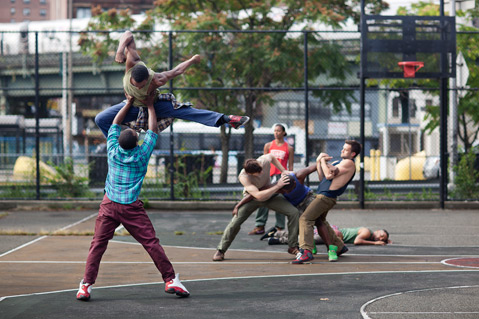Abraham.In.Motion Makes S.B. Debut
N.Y.C.-based Company brings Pavement to UCSB’s Campbell Hall

Pittsburgh native Kyle Abraham was just 14 years old when the John Singleton film Boyz n the Hood came out in 1991. Set in South Central Los Angeles, the movie told the story of young black men wrapped up in the infamous gang warfare between the Bloods and the Crips. Two thousand miles away, 8th-grader Abraham felt a powerful resonance with the themes of the film.
“It’s a film about how we start out, how we see ourselves, and how others see us,” he explained recently. “It’s about how we’re told who we are before we know who we are.”
Now a choreographer in his mid-thirties, Abraham remains fascinated by that particular moment in American history — much of his work circles around the black American experience of the 1980s and ’90s. That’s certainly the case with Pavement, an evening-length dance he’ll bring to UCSB’s Campbell Hall for two nights next week on Tuesday, April 22, and Wednesday, April 23.
In creating Pavement, Abraham says, he thought of Boyz n the Hood as a time capsule: a reflection of the late 20th century.
“It was a time of HIV and AIDS — a whole community having to be educated about the disease,” he noted. “It was a time of crack cocaine being brought into the community, a time of violence. I thought about the whole era as a genocide almost — an urgency to erase the black race.”
At the same time, Abraham thought back further to what he called “the soul of black folks: jazz legends like Art Blakey.” Walking through downtown Pittsburgh, he began to see the dilapidated urban landscape as a place that “once had so much vitality.”
As an award-winning choreographer and MacArthur Fellow running his own company, Abraham’s not claiming to be a product of the ghetto. On the contrary, he’s quick to explain that he studied music and visual art at his Pittsburgh elementary school, played a role in his high school musical, and was always encouraged to pursue his interest in the arts.
Yet it wasn’t until legendary American choreographer Bill T. Jones gave a lecture/demonstration at his high school that Abraham saw a future for himself in dance.
“I was kind of blown away by the company, by how confident they were in themselves,” he remembered. “It was something I hadn’t really seen before. I had just started dancing that year, and suddenly I was finding out that people were creating dances with meaning and talking about what movement was derived from.”
Armed with this new understanding of what dance could be, Abraham went on to study dance at SUNY Purchase but maintained his interest in other arts forms. Unlike many successful young choreographers, his path has taken him away from dance entirely for periods; he spent a number of years pursuing a career in music and working in art museums before finding his way back to choreography. That innate versatility and curiosity finds its way into his works; Pavement features film projection and spoken text as well as movement.
Musically, too, Abraham draws on a wide range of influences. The score for Pavement is drawn primarily from opera, specifically works composed for castrato singers.
“When I started making this project, I was thinking about the fact that from inside a gang mentality, it’s violent acts that make you a man,” Abraham explained, “yet for a castrato, it’s a violent act that emasculates.”
With his dancers, as with all his artistic influences, Abraham casts a wide net. The seven dancers in Pavement come from varied performing backgrounds, from those brought up in the club dance scene to salsa, modern dance, and ballet-trained dancers.
As for the target audience, Pavement may not be the ideal work for children, due to its themes and language. For Abraham, giving performers a chance to speak onstage “adds to the humanity of the work.
“That’s always an interest of mine: making realistic and honest choices in my work,” he explained. “My two works previous to Pavement also had text in them but not always in the way people would expect to find text in contemporary dance or dance theater work.”
4•1•1
UCSB Arts & Lectures brings Abraham.In.Motion to Campbell Hall Tuesday-Wednesday, April 22-23, at 8 p.m. For tickets, call (805) 893-3535 or visit artsandlectures.sa.ucsb.edu. To learn more about the company, check out abrahaminmotion.org.



